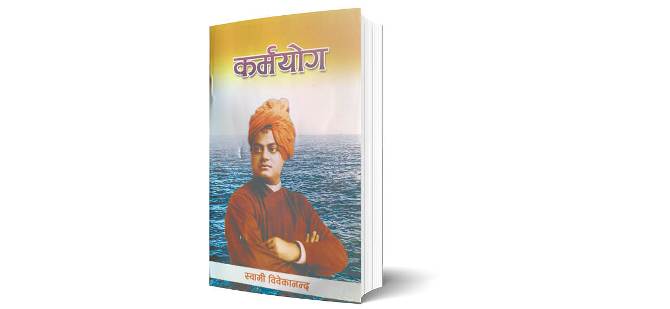Swami Vivekananda’s ‘Karmayoga’ In Nepali

Gandhi Raj Kafle
Swami Vivekananda needs no introduction. The conscious world, which is eager to know about Vedic values, philosophy and religions, knows him very well. The books written by him are common assets not only for the Hindus but are for all inquisitive people, who want to enrich the mind and soul with knowledge of spiritualism.
The love to read Vivekananda's spiritual teachings among the Nepali readers is deep. His works, which are in the English language, are popular in the academic circles of Nepal. Similarly, the Hindi version publications are also popular. Yet, it must also be said here in Nepal that Nepali is the common tongue of many people and in this regard, it is a welcome initiative as someone has published Vivekananda's teachings in simple and correct Nepali through the medium of translation.
The under review book entitled "Karmayoga" by Vivekananda has also been translated in Nepali. The book is an outcome of a collaboration of two important institutions, namely, the Ramkrishna Ashram Nepal and the B. P. Koirala Bharat Nepal Foundation. The translator of this book from Hindi to Nepali is Shiva Dutta Dhakal.
In fact, the size of the book is small with only 122-pages and consists of eight pieces of writings by Vivekananda. Each piece offers an enlightening reading offering ease of our mother tongue. The word 'small' in terms of book size meaningfully amplifies spontaneously as Vivekananda explains the true meaning of Karmayoga in this book and the knowledge shared by the World famous Guru immerses readers with precious instances of the Vedic characters and the Sanskrit Slokas.
Considering these facts, the book cannot be termed as small one. It is like Prasad or ambrosia of knowledge, which is always small. But, the holiness of the sacred feelings the Prasad gives is joyous. Vivekananda's "Karmayoga" is like this.
Karma or work, without which we cannot live, has a deeper meaning. Swamiji has precisely made this part understandable. So, let's examine these eight titles in the book, which have sweetly made the secret of 'work' understandable for us, the social beings.
The first title is 'Impact in Character of Karma', the second 'All Works are Significant in Their Own Way', the third 'Secret of Karma' and the fourth one is 'What is Duty'. Similarly, the fifth title of the writing is, 'There is Wellbeing for Ourselves in the Work of Philanthropy', the sixth, 'To Become Desire-less is True Sacrifice', the seventh, 'Salvation' and the last one, 'Ideal of Karmayoga'.
If spiritualism is the means of Mokchhya or salvation at the end of life, then there must be supreme interconnectivity, which is not anything but Karma itself. This is what Vivekananda has emphasised conclusively in this useful book. The Swamiji has some excellent examples, too, to explain Karmayoga.
It would be relevant to present one such here. This story is related to the Pandavas, who performed a big Yagna after winning the War of the Mahabharata. They donated huge properties, fed a big number of Brahmins and made all happy in the Yagna. But, in the meantime, a small creature called Nyaula comes to visit the Yagna of the Pandavas and says the Yagna is pompous and useless. It says, "The previous one, which I had experienced, was superior."
Everyone became surprised, but Nyaula calmly explained that he had visited a poor family's house then when they were ready to eat whatever the meal they had after five days of hunger. Guest Nyaula then said, "I am hungry for ten days, so, feed me also."
They happily divided the meal to him, too. Nyaula ate, but said, " this meagre meal only increased my hunger." So, the wife happily offered her meal to guest Nyaula then turn-by-turn husband and other family members also fed him their meal to the Nyaula.
Surprisingly, all the family members who were unfed for many days succumbed to hunger and guest Nyaula who had offered blessings to them rubs his body in the place where they had cooked the meal before departure. The half of the body of the Nyaula had turned golden with some leftover particles of flour of the meal of that poor family. Since then the Nyaula had been travelling different parts of the world to make the other half part of his body golden by touching such a sacred place and he could not achieve it even after coming to the place of Yagna by the Pandavas. So, which is a superior donation- the donation of that poor family or the huge donation performed by the Pandavas of the Mahabharata?
This is the example of Vivekananda to prove the difference between beyond desire and donations with desire.
There is no more to say about this book because the author's name itself tells a lot. But, to the Nepali readers, the efforts and initiatives of the institutions like the Ramkrishna Ashram Nepal and the B. P. Koirala Bharat-Nepal Foundation are praiseworthy. Credit also goes to Shiv Dutta Dhakal for his skillful translation to bring this book out from Hindi to Nepali.
Recent News

Do not make expressions casting dout on election: EC
14 Apr, 2022
CM Bhatta says may New Year 2079 BS inspire positive thinking
14 Apr, 2022
Three new cases, 44 recoveries in 24 hours
14 Apr, 2022
689 climbers of 84 teams so far acquire permits for climbing various peaks this spring season
14 Apr, 2022
How the rising cost of living crisis is impacting Nepal
14 Apr, 2022
US military confirms an interstellar meteor collided with Earth
14 Apr, 2022
Valneva Covid vaccine approved for use in UK
14 Apr, 2022
Chair Prachanda highlights need of unity among Maoist, Communist forces
14 Apr, 2022
Ranbir Kapoor and Alia Bhatt: Bollywood toasts star couple on wedding
14 Apr, 2022
President Bhandari confers decorations (Photo Feature)
14 Apr, 2022










